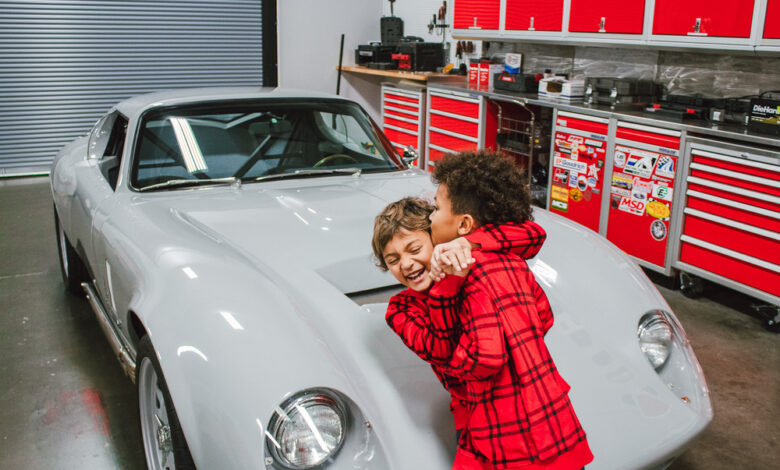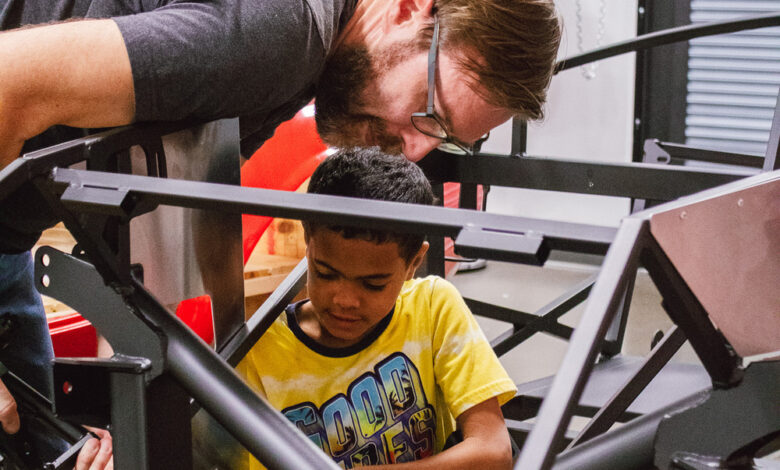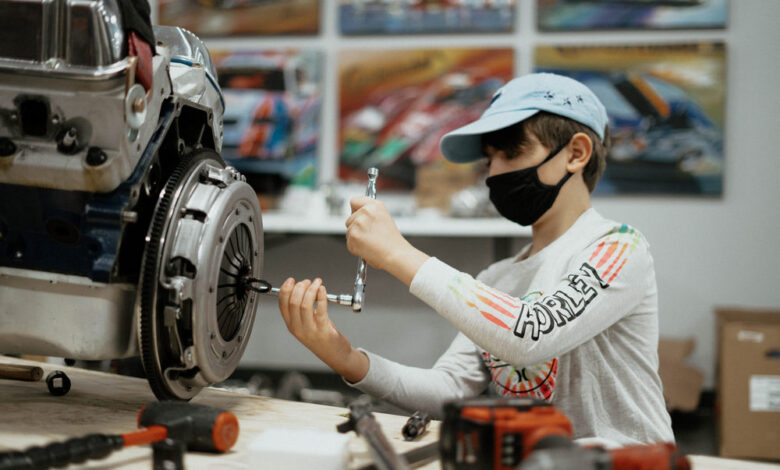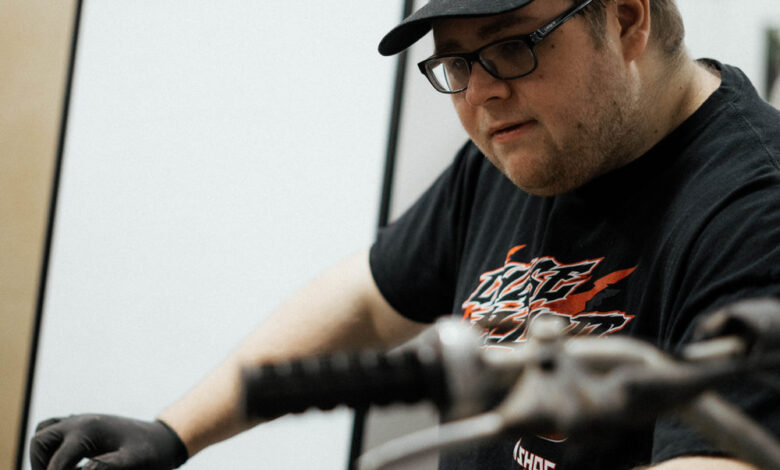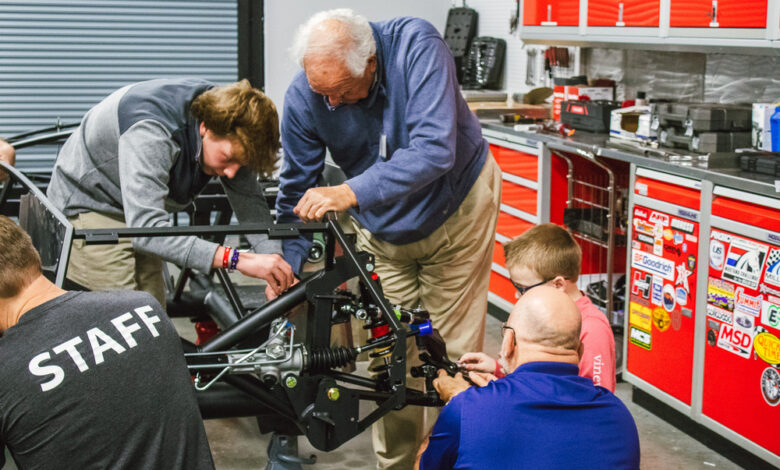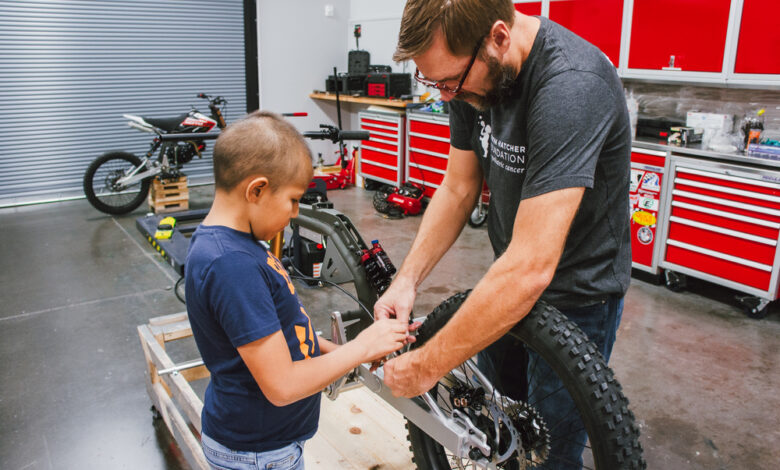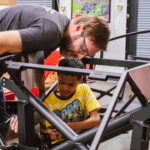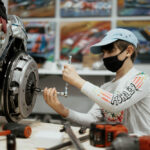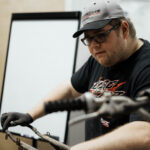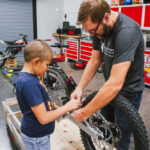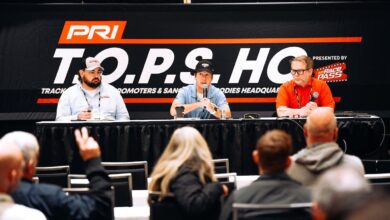Inspiration & Empowerment: Inside the Austin Hatcher Foundation
How the industry helps support the organization’s important mission.
This article originally appeared in the June 2023 issue of THE SHOP magazine.
In October 2006, Austin Hatcher Osborn was diagnosed with a rare and aggressive form of brain and spinal tumors called atypical teratoid/rhabdoid tumor (ATRT). The oncologist explained to parents Jim and Amy Jo Osborn that the fatality rate was 100%.
Currently, ATRT still lacks viable treatment options and, at only eight weeks old, infant “Hatch” was too young to withstand prolonged, intensive treatment. The Osborns watched their son’s condition quickly deteriorate as the cancer invaded his central nervous system and continued to spread.
Shortly after diagnosis, Hatch returned home from the hospital and, within a week, took his last breaths among the comfort of his parents’ unconditional love.
Channeling their heartbreak, the Osborns founded The Austin Hatcher Foundation for Pediatric Cancer (AHF), headquartered in Chattanooga, Tennessee, that provides services nationwide. At AHF, staff members embrace its mission “to erase the effects of pediatric cancer and optimize each child’s quality of life through essential specialized intervention—beginning at the time of diagnosis and continuing throughout survivorship.”
As such, the foundation provides critical services through four main divisions: Industrial Arts Therapy, Diversionary Therapy, Psycho-Oncology and Healthy Lifestyle Education.
Approximately 15,780 children, from infants to 19-year-olds, are diagnosed with cancer each year in the United States. While 85% of pediatric cancer patients now survive five years or more thanks to major treatment advancements, The American Cancer Society says overall survival rates still vary greatly.
“For me, our work at AHF is an opportunity to turn tragedy into inspiration and empowerment,” says Amy Jo Osborn. “I believe everyone’s life has adversities. Some might seem larger than others, but God’s grace is sufficient. He had a plan for Hatch and our family—to do all we can (for pediatric cancer patients) in his honor and to allow families the opportunity to survive, succeed and thrive after a pediatric cancer diagnosis.”
THE FOUNDATION
Today, 12 full-time and five part-time staff members, along with 150 annual volunteers, partner with numerous hospitals, community organizations and benefactors to help address the mental health and well-being needs of patients and their families.
The stressors of a pediatric cancer diagnosis are vast, from physical exhaustion, pain and side effects to mounting medical bills, neglected household responsibilities and impacts on siblings. The entire ordeal takes a significant toll on patients and their loved ones—a complex burden the foundation strives to lessen as the region’s only psychosocial center.
At the AHF Education Advancement Center, staff works alongside an interdisciplinary group of experts to administer evidence-based standards of care, including mental, emotional, social and spiritual support the patients and families require during this traumatic time.
Through clinical and psycho-oncology programming, AHF is committed to helping patients cope in the present and thrive in the future.
In 2020, the foundation expanded services when many businesses were shuttered during the pandemic. Osborn says telehealth was established at AHF prior to COVID-19, but the lockdowns pushed the service mainstream. While other medical and wellness facilities started at ground zero, AHF was already prepared to implement telehealth services into patient care.
Moreover, out-of-pocket funds and insurance are not collected, alleviating some of the disparities of healthcare for families who cannot afford these types of invaluable services, says director of development Melanie Hammontree.
Since its inception, AHF has treated more than 89,000 individuals across 23 states and 42 children’s hospitals. In 2022 alone, the foundation administered 43 neurocognitive tests, coordinated 145 family program events and completed 15,080 clinical hours ($4.7 million in valued services) on behalf of 972 patients.
“The most rewarding part of working at AHF is seeing firsthand the impact the foundation is having on the lives of children and families who are facing a pediatric cancer journey,” Hammontree says, “the smiles on the children’s faces, the laughter, as well as the relief in a mom’s voice to know she is not alone—that she has AHF families who are walking or have walked a similar journey and AHF staff members who pour themselves into this critical, invaluable work.”
The foundation is celebrating a company milestone of 1,600% growth, with staff and volunteers spearheading more than $20 million in free, holistic and comprehensive-coordinated care.
COMFORTS OF HOME
What started as a small office grew into a 2,500-square-foot facility and eventually evolved into the current 33,000-square-foot Chattanooga location. Though the space is large, marketing coordinator Shayna Webb says it is still family-friendly and welcoming, featuring plenty of creature comforts to help clients relax.
“No waiting rooms. We want our facility to feel like home. The whole setup is anything but clinical,” she notes.
Visitors are welcomed into an inviting living room with a fireplace and adjacent kitchen where they can help themselves to snacks and drinks. Webb stresses the entire family is invited to attend appointments. Team members are available to “hang out” with younger siblings, while patients and parents meet with clinical staff. A play area, ping-pong tables and a wood shop are available for use as well.
When the pandemic hit and interrupted traditional programming, the foundation still found ways to help patients and their families take their minds off cancer. Activity, art and learning packages were sent straight to client homes, so kids could find a fun escape during quarantine.
AHF even hosted a virtual “camp” with collaborative activities for attendees. History teachers, fitness specialists and dance and art instructors joined the fun, bringing joy to patients and their siblings through virtual classes.
“It’s about walking through every step of the childhood cancer journey with them, and that includes the entire family,” Webb says. “The positive feedback we receive, the stories people share with us—it inspires us to keep working, to keep going.”
POWERED BY THE AUTOMOTIVE INDUSTRY
The foundation is firmly rooted in the auto racing community, as former Southern Living photographer Amy Jo met her husband, orthopedic spine surgeon and race car driver Jim, years earlier at the track.
Even before Hatch was born, the Osborns felt called to serve pediatric cancer patients, having coordinated trackside attendance at Michelin Raceway Road Atlanta for more than 150 families annually.
They view a day at the races as an effective form of Diversionary Therapy, a methodology that provides interactive, specialized activities for young patients and their family members. Through AHF, the Osborns tailored certain services, programs and fundraising to reflect a passion for automobiles and motorsports.
“The founding of AHF is a beautiful example of resiliency and innovation, as the Osborns turned their tragedy into a lifegiving foundation and aligned it with the racing industry to bring in revenue,” Hammontree says.
Today, AHF is an official charity of the Specialty Equipment Market Association (SEMA), International Motorsports Association (IMSA), Michelin Raceway Road Atlanta and Foothills Title Services.
Hammontree says all four corporate partners contribute thousands of dollars per year through annual givebacks. To date, SEMA and IMSA rank as AHF’s most successful fundraising campaigns—garnering national recognition, building strategic partnerships and driving revenue to support the organization’s mission.
As a result, Osborn says the foundation now provides Diversionary Therapy at IMSA racing events across the country.
Additionally, youth education is conducted through the foundation’s “Fueling Potential – Racing To Win” program, which explains four important steps to help prevent cancer later in life: routine exercise, heathy eating habits, sun safety and being tobacco-free.
AUTO PROJECTS AS THERAPY
In addition, AHF utilizes Industrial Arts Therapy, a STEM-based educational therapy program that encourages children to apply freedom of movement as a form of rehabilitation.
Children learn to fabricate objects in wood or metal using a variety of hand, power and machine tools. Industrial Arts Therapy also includes small engine repair and automobile maintenance activities, such as participation in the Driving Performance Improvement Program and custom-building vehicles in the Foundations Auto Shop.
The unique therapy options not only help treat and improve coordination deficits, memory loss and behavioral or learning struggles, but also teach children valuable shop and life skills they can utilize well into the future, from basic home repairs to craftsmanship and machine safety.
Daniel Fosbinder, industrial arts manager, also emphasizes how participants have the distinct opportunity to ignite a passion they might not know exists.
“The program is open to anyone (clients) who wants to participate. With the help of clinical staff, we evaluate where they are developmentally, then cater a project to that child,” Fosbinder says, noting the program has the professional facility, tools and staffing to accommodate a one-off or ongoing projects, from full vehicle builds to crafting rocking chairs and picnic tables.
From custom-made highchairs and bird houses to baseball bats, AHF accommodates special requests. For Webb, refining fine motor skills, overcoming adversity, building confidence and experiencing a sense of accomplishment are central to any project.
“Two elementary-age brothers completed a custom-built guitar project, which was fun. It took hours and hours of sanding, shaping the neck and hand tapping, cutting, filing and fitting before a final product was in hand, but it was a rewarding project,” Fosbinder recalls.
On the automotive side, vehicles and components are donated by sponsors. Participants learn to disassemble, retrofit new parts or complete a full build. The entire program is individualized—some work singularly, while others participate in small groups to tackle an engine, chassis or exhaust project.
“The foundation’s alignment with the racing industry is in its DNA, so the industrial arts division is a natural fit,” Hammontree explains. “From a therapeutic perspective, industrial arts programming uses tools to inspire creativity and a passion for learning, plus helps patients recover physically, mentally and socially after treatment. The program provides an opportunity to build a brighter future by sparking an interest in pursuing a career in the automotive industry.”
One build that stands out to Fosbinder is a Factory Five Type 65 Coupe, designed to be an accurate replica of the original 1965 World Championship Daytona Coupe. Several families worked on the project over more than eight months, including a father and his four boys.
Fosbinder recalls the father expressing sincere gratitude for the one-of-a-kind opportunity to collaborate on the build alongside his children. It’s a reminder that beauty and joy are still present among grief and tragedy.
“Another prominent project was a small, 90cc Motoped motorcycle. Several kids had their hands on the project, including an 8-year-old girl who helped assemble and install the carburetor. Two of the young men (participating in the project) finished treatments and came back to work on it, while the other patient was still in active treatment,” Fosbinder says. “Some days he didn’t feel well, but all he wanted to do was work on that bike. It wasn’t a big build like the coupe, but he was so proud of it and the results were so impactful.”
Certain completed projects head to the annual SEMA Show for display and then to auction as a way to further fundraising efforts. To date, AHF has completed 16 vehicle builds totaling more than $2 million in additional funding for the organization.
Among them, Osborn points to a Dodge Viper (VIN 001 2013), which hauled in $300,000. Dr. Jim Osborn gifted his professional race car, a Volkswagen TDI Jetta, that sold three separate times via donors buying and giving it back to auction for a total of $500,000.
In addition, a SATA German Engineering Factory Five custom build led by the Industrial Arts STEM program sold on Bring a Trailer for $137,500.
Fundraising is essential to continuing services, but Fosbinder notes it does not define “the why” behind AHF.
“For me, it’s not about completing a project at all. That is not how I define success,” he says. “Success is when a child, teen or young adult comes back in the door week after week and wants to keep building the car, the motorcycle, the baseball bat. Success is parents telling you their child couldn’t wait to come back and finish what they started. And even then, the program is less about the actual build and more about the time spent and the impact on the children and their families. Success is hearing the testimonies and seeing the smiles firsthand.”
Such achievements align with the organization’s main mission.
“Everything we do is about lifting spirits and engaging and teaching valuable skills they can apply in their future during and after pediatric cancer,” Fosbinder says.
LOOKING AHEAD
AHF celebrates its achievements in helping children and families navigate the complexities of a cancer diagnosis, but Osborn notes the foundation does not intend to rest on its laurels. The organization is doubling down on its vision to expand nationally, so more patients and their families can access these important services.
To achieve its goal, the foundation continues to refine its strategic priorities for the road ahead:
- Exceed Expectations. Providing much-needed services for AHF children and families. Osborn says AHF aims to not only add more clinical staff to meet the higher demand for services, but also provide a more comprehensive road map so the services they do provide have the most impact.
- Grow/Expand. Extending AHF’s reach and impact, so more families can access services. To lay the financial groundwork necessary for achieving this goal, Hammontree says the foundation plans to streamline revenue for short- and long-term sustainability and growth, thereby increasing fundraising and awareness. AHF plans to seed additional locations when funds are available and the timing is right to do so.
- Strengthen/Empower. Ensuring AHF and the AHF team have the resources and support they need to flourish. Hammontree notes the importance of defining individual and team goals, setting clear metrics for tracking progress and determining clear timelines for objectives to be achieved. Doing so will allow the organization to reach its goal to serve more families regionally and nationally.
- Collaborate/Educate. Building relationships to increase awareness and support growth initiatives. AHF clinical and development teams remain focused on promoting the foundation’s mission, vision and impact, while actively identifying strategic community partners and collaborators.
Hammontree stresses the importance of community engagement, particularly in building relationships and support at the local and national levels.
“During my short tenure at AHF, I have seen tremendous growth in the team,” she says. “We have a common goal, and we are learning to work smarter, not harder, to achieve it.”
Building the volunteer program and honing marketing initiatives are key areas for 2023, with survivors and their families playing an influential role in both. Webb says many clients stay on board, participating in grief camps and then transitioning to the volunteer program following treatment.
“One cancer survivor used our services, finished chemo in high school and now volunteers as part of the teen ambassador program,” she notes, emphasizing these faces of the foundation are also paramount in outreach initiatives.
This year, AHF’s marketing strategy is focused on “the who” (the families AHF serves), “the what” (the services provided), “the why” (the need for these vital services for families going through this trauma) and “the win” (sharing successes).
Webb notes services and support continue for families who lose a child, making fundraising efforts all the more important.
“We have an Honoring the Journey wall in memory of those who passed. The siblings still come and touch their family plaque,” she says. “It’s not just about carrying on the memories and name, but rather a physical reminder that their memory always lives on—just like Hatch.”
For more information about how AHF serves pediatric cancer patients and their families across the country, call (423) 243-3471; email: info@hatcherfoundation.org; or follow its social media accounts on Facebook, Instagram, LinkedIn and TikTok.
